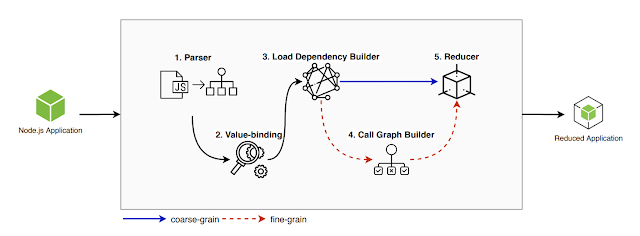Mininode is a CLI tool to reduce the attack surface of the Node.js applications by using static analysis of source code. It supports two modes of reduction (1) coarse, (2) fine.
Mininode constructs the dependency graph (modules and functions used) of the application starting from main file, i.e. entry point of the application. Mininode initializes entry point to package.json file's main field if it exists. Otherwise default to index.js.
Example usage: node index.js <path to Node application root folder> --mode=(coarse|fine). Below is the list of options that can be passed to Mininode.
Options
List of command line options that can be passed to mininode.
--destination, -d: the path where mininode will save the reduced Node.js application. The default value:mininode.--dry-run: just generates mininode.json without modifying the initial application.--mode, -m: reduction mode. The value can be eithercoarseorfine. Incoarsemode mininode will perform only coarse-grained reduction. While infinemode mininode will perform fine-grained reduction. In general coarse-grained reduction is more reliable, because mininode will not try to reduce unused functions inside the module. Default value:coarse.--silent: console output is disabled. This will improve the performance of the mininode.--verbose: outputs additional information to the console. The default value:false--log: mininode will generate log file inside, which contains dependency graph of the application in json format. The default value:true.--log-output: the name of the log file generated by mininode. The default value:mininode.json.--compress-log: compresses the final log file. By default it will dump everything into log file. In production it is advised to pass the--compress-logflag to save space.--seeds: seed files from where mininode will start building dependency graph. You can provide many seed files by separating them with colon.--skip-stat: skips calculating the statistics--skip-reduction: if passed mininode will not reduce the JavaScript files. The default value:false.--skip-remove: if passed mininode will not remove unused JavaScript files. The default value:false.
Limitaions
- Mininode uses static analysis, which means it can not reduce the attack surface of the Node.js application which uses dynamic behaviour, such as
eval. If Mininode detects dynamic behaviour in the application it exits with errorDYNAMIC_BEHAVOUR_DETECTED.
Research Paper
You can read more about the details of our work in the following research paper:
Mininode: Reducing the Attack Surface of Node.js Applications [PDF]
Igibek Koishybayev, Alexandros Kapravelos
Proceedings of the International Symposium on Research in Attacks, Intrusions and Defenses (RAID), 2020
If you use Mininode in your research, consider citing our work using this Bibtex entry:
@conference{mininode-raid20,
title = {{Mininode: Reducing the Attack Surface of Node.js Applications}},
author = {Koishybayev, Igibek and Kapravelos, Alexandros},
booktitle = {{Proceedings of the International Symposium on Research in Attacks, Intrusions and Defenses (RAID)}},
year = {2020}
}

